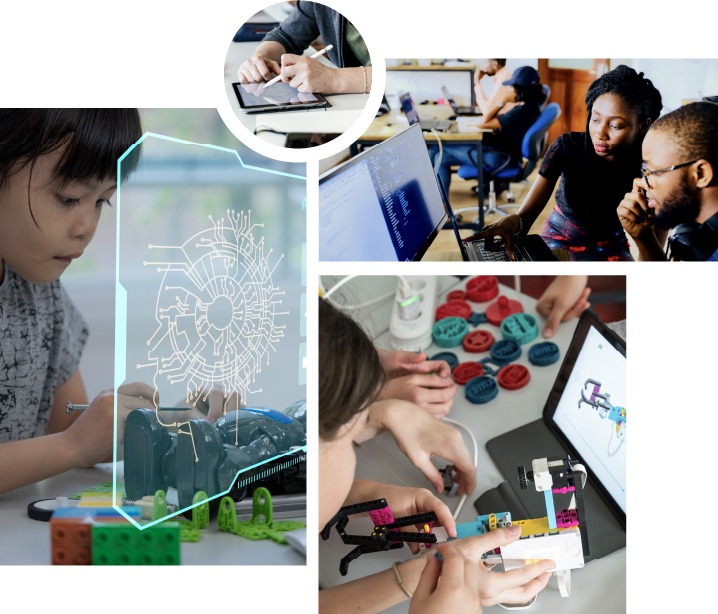Artificial intelligence is rapidly changing the American workforce. While that has caused trepidation and fear of technology displacing human employees, AI is also creating opportunities for otherwise disadvantaged people to gain new skills and get jobs.
Nonprofit leaders and some educational institutions have embraced AI as a tool to help set up young adults for success and assist older workers in gaining marketable skills.
In Washington, regulatory efforts are predictably slow. So far, the main message from the White House and on Capitol Hill is that more information and data are needed to predict how AI will affect the future of work.
In this edition, we explore how the nonprofit world is using AI to prepare the next generation of the workforce and how policymakers are working toward a balanced regulatory approach. Be sure to listen to our accompanying podcast as we dissect the issue and check out the rest of our AI Impact series here.
Grow with Google launches a new generative AI course for educators in collaboration with MIT RAISE
Offered at school districts across the country, the two hour self-paced course is designed to help teachers build essential AI skills to help them save time on everyday tasks, personalize instruction and enhance lessons to better meet students needs.
Current State of Play in Washington
The federal government has acknowledged that AI is critical to education and job training but it will take some time for concrete action on the issue to emerge.
Meanwhile, the Department of Education’s Office of Educational Technology says it supports the use of technology, including AI, to “improve teaching and learning, and to support innovations throughout educational systems.” But DOE also urges educational institutions to exercise caution to protect against the “dangers” that could arise from integrating AI into education technology.
Expert shortages: The Biden administration has hired more than 150 “AI and AI-enabling professionals” since October when President Joe Biden issued an executive order on AI. Those experts are involved in permitting policy, deciding how and where the government should invest in AI and helping write overall AI policy for the administration.
However, as the government embraces AI, it faces a critical challenge in attracting skilled experts. Federal agencies must compete with well-funded private companies that can afford to offer higher salaries for AI professionals.
The executive order on AI also includes a provision to ensure AI isn’t being used in ways that violate employment discrimination laws. Still, the administration hasn’t issued any rulemaking to provide certainty for how AI can be best deployed in the workplace and educational institutions.
I have seen more focus in the last two years in Congress on AI and what the impact will be.
Rep. Lisa Blunt Rochester (D-Del.)
On the Hill: In Congress, the New Democrat Coalition’s AI Working Group wants to guarantee the public sector is properly staffed with the nation’s leading AI workers.
The center-left working group has written to the Biden administration urging officials to ramp up its AI hiring efforts to ensure the government can remain competitive against the private sector.
Several other lawmakers are introducing legislation aimed at shaping the workforce of the future as AI becomes more widely used.
A bipartisan effort from Reps. Darren Soto (D-Fla.), Lori Chavez-DeRemer (R-Ore.), Lisa Blunt Rochester (D-Del.) and Andrew Garbarino (R-N.Y.) aim to push the federal government to look into the workplace implications of AI.
The legislation authorizes the Labor Department and the National Science Foundation to draft a report on how AI’s future growth will affect the U.S. workforce. While the measure enjoys support across the aisle, it hasn’t come up for a vote in the House. Some in the private sector view this kind of effort — a request for reports — as slow-walking compared to how fast the AI field is moving.
The Spotlight Interview: Hopeworks CEO Dan Rhoton
Dan Rhoton, the CEO of the New Jersey-based job training nonprofit Hopeworks, firmly believes AI can help prepare underprivileged young adults to enter the workforce.
Hopeworks utilizes AI tools to upskill Camden, N.J.-area residents over 17 and connect them with local employers. Rhoton sees the technology as a way to level the playing field between Hopeworks’ participants — who disproportionately face housing, mental health and education challenges — and the rest of the workforce.
Rhoton told us that in tech fields like coding, AI-enhanced training can transform an entry-level employee into a worker who is as productive as one with 10 years of experience. Rhoton is hopeful that because of AI, more of Hopeworks’ graduates will be considered by companies that might not typically take a risk on a new hire.
As is often the case with developing technology, leaders outside of the government space are frustrated at Washington’s slow pace. Rhoton said he feels Congress is behind the curve on AI and begged for increased clarity on regulation from lawmakers.
Rhoton’s remarks have been edited for brevity and clarity.

“In AI, there’s no structural gap. Nobody knows what they’re doing with AI, which means our young adults can master it and move quickly.”
“We use AI as a co-pilot. It’s not going to do the coding for you. But it is going to write some basic code for you to revise. It’s going to do error correction. If it’s your first professional job and you don’t know how to write that professional email to your boss, you can ask ChatGPT 20 times to change the tone until it’s just right. We can also use AI to customize resumes for any particular positions.”
“I think the biggest thing that legislators could do is develop some clear and unambiguous regulation so that we can get to work. That is the thing that’s keeping folks, including Hopeworks, from really solving some of these problems — is that it’s such a Wild West field.”
“We’re going to have a blue-ribbon panel telling us about what we did three years ago. Stuff is going to happen. If we move fast, it could be what we want to have happen. If we spend a lot of time studying it, then we will develop a really good report about what we should have done.”
“Folks are worried about how AI will disrupt the status quo. If you’re a young adult who’s homeless, if you’re a young adult who can’t get a job, the status quo isn’t very good.
“There are risks for sure. The risks of AI are as yet unknown. Let’s work on that. But you know what? We do know the risks of poverty. We do know the risks of folks not having enough to eat. We do know the risks of trauma and violence. And if we use AI, we can solve those issues.”
The Policy Pipeline
There are several AI proposals lawmakers have floated in both the House and the Senate, although top Hill staffers we spoke with were realistic about their chances in this Congress.
Last year, Blunt Rochester, who’s seeking Delaware’s open Senate seat, introduced a package that seeks to keep the United States competitive in immersive technology and AI job training.
“The technology is moving faster than the policymakers and the people,” Blunt Rochester told us. “I have seen more focus in the last two years in Congress on AI and what the impact will be. It’s why we want to have a study on its impact on the workforce.”
Blunt Rochester touted bills that would promote augmented and virtual reality for job training in fields like health care and welding.
Over in the Senate, Sens. Gary Peters (D-Mich.) and Eric Schmitt (R-Mo.) have introduced bipartisan legislation they contend would build the AI and cybersecurity workforce pipeline in the U.S.
The measure would also implement a strategy to prepare workers for emerging technology.
A step in the right direction: A bipartisan group of senators has, in recent months, been conducting listening sessions on the impacts of AI. Sen. Mike Rounds (R-S.D.), who helped form the group, told us AI has great potential to make the workforce more efficient.
Rounds, however, acknowledged there’s little chance of AI legislation becoming law before the election. But he said it was “a step in the right direction” that lawmakers are having conversations about AI.
“We don’t want to have a regulatory impact that slows down our development,” Rounds said. “But at the same time, we want to provide incentives so that development of AI occurs in our country, rather than in other places.”
— Max Cohen
New Google Essentials course to help everyone learn to use AI
As the demand for AI-related professional skills increases, Google has launched AI Essentials, a self-paced course designed to help people across roles and industries learn AI skills to boost their productivity. To make sure that people have access to AI training, including this course, Google.org has launched a $75 million AI Opportunity Fund to train Americans on critical AI skills.



